You also want an ePaper? Increase the reach of your titles
YUMPU automatically turns print PDFs into web optimized ePapers that Google loves.
8 CHAPTER 7. INFINITE PRODUCT SPACES<br />
(1) A, B 2 S implies A \ B 2 S .<br />
(2) If A 2 S , then there exist Ai 2 S disjoint such that A c = S n i=1 Ai.<br />
It is easy to verify that semialgebras on W automatically contain W and ∆.<br />
Lemma 7.13 The following are semialgebras:<br />
(1) S = {(a, b] : • apple a apple b apple •}<br />
(2) S = {A1 ⇥···⇥An : Ai 2 Ai} where Ai are algebras.<br />
(3) S = ⇥ Aa : Aa 2 Aa &#{a : Aa 6= Wa} < • provided Aa’s are algebras.<br />
a2I<br />
Proof. Let us focus on (2): Since all Ai are p-systems, S is closed under intersections.<br />
To show the complementation property in the definition of semialgebra,<br />
let D be a collection of all sets of the form B1 ⇥···⇥Bn, where Bi is either Ai or A c i ,<br />
but such that A1 ⇥···⇥An is not included in D. Then<br />
(A1 ⇥···⇥An) c = [<br />
From here the complementation property follows by noting that D is finite and<br />
D ⇢ S .<br />
Next we will show that via finite disjoint unions semialgebras give rise to algebras:<br />
Lemma 7.14 Let S be a semialgebra and let S be the set of finite unions of sets Ai 2 S .<br />
Then S is an algebra.<br />
Proof. First we show that S is closed under intersections. Indeed, A is the (finite)<br />
union of some Ai 2 S and B is the (finite) union of some Bj 2 S . Therefore,<br />
✓<br />
[<br />
A \ B =<br />
i<br />
Ai<br />
◆<br />
\<br />
B2B<br />
B.<br />
✓ ◆<br />
[<br />
Bj =<br />
j<br />
[<br />
Ai \ Bj.<br />
i,j<br />
Since Ai, Bj 2 S , then Ai \ Bj 2 S and A \ B is the finite union of sets from S .<br />
Consequently, A \ B 2 S .<br />
Next we will show that S is closed under taking the complement. Let A be as<br />
above. Then<br />
A c ✓<br />
[<br />
=<br />
◆c = \ \ [<br />
= Bi,j,<br />
i<br />
Ai<br />
where Bi,j 2 S are such that A c i is the union of Bi,j—see the definition of semialgebra.<br />
The union on the extreme right is finite and, therefore, it belongs to S . But<br />
S is closed under finite intersections, so A c 2 S as well.<br />
Now we will learn how (and under what conditions) a set function on a semialgebra<br />
can be extended to a measure on the associated algebra:<br />
i<br />
A c i<br />
i<br />
j
















